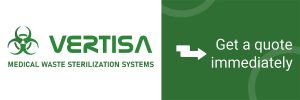Medical Waste: According to the Medical Waste Control Regulation, it refers to infectious waste, pathological wastes and cutting drilling wastes from health institutions.
Infectious Wastes: To prevent the spread of infectious agents, their transport and disposal are waste that requires special application.
Infected wastes include one of many pathogenic microorganisms.
Microbiological laboratory wastes, culture and stocks, infectious body fluids, serological wastes, other contaminating laboratory wastes, blood and blood products and contaminated objects, used surgical wounds, dialysis wastes, quarantine wastes, air filters containing bacteria and virus, blood and all objects in contact with them.
Pathological Wastes: Anatomical waste tissues, organs and body parts, surgery, autopsy and so on. body fluids arising during medical intervention:
Body parts arising from places like operating room, morgue, autopsy, forensic medicine, organic parts,placenta, cut limbs etc. (human pathological waste)
Cutting Drill Wastes: Wastes that may cause sinking, puncturing abrasions and injuries:Injector needles, other cutters containing needles, bisturia, lamellae, glass pasteur pipette, broken glass etc.
At the disposal of medical waste; burning and sterilization methods can be used.
However, the sterilization method is cheaper than the medical waste sterilization incineration plant, which is easier to use and easier to train for employees.
The disposal method applied in the developed countries for the disposal of medical wastes by the Medical Waste Control Regulation and the General Directorate of Environmental Management of the Ministry of Environment and Urbanization have opened the way for the application of sterilization technologies in our country.
According to this, infectious wastes and cutting-piercing wastes can be made harmless by subjecting them to sterilization process and these wastes, which become riskless, can be disposed and stored in domestic waste storage areas.
Sterilization: With a simple statement, is the killing of disease-causing agents.
It is aimed that all microbial life including bacterial spores should be completely destroyed by the methods applied, or that the level of these microorganisms should be reduced by 99%, and the number of microorganisms should be reduced by one millionths.
STERILIZATION METHODS
1- Thermal Methods
2- Chemical Methods
3- Irradiation Methods
4- Biological Methods
Thermal Methods
In low-temperature processes, thermal energy is inadequate and low as it makes the medical waste non-hazardous and does not cause it to decompose chemically or to support burning or thermal degradation.
- Generally these processes are operated between 93-177 degrees.
- They are divided into two main groups: wet heat (steam) or dry hot air.
- Wet heat treatment is carried out using an autoclave to disinfect the waste.
Sterilization with Steam Autoclave
Autoclaving is the disinfection of infected wastes and cutters by an efficient wet heat treatment.
Three things are important in this process:
- Temperature, pressure and contact time.
- Heat grade and pressure are constantly monitored.
- In autoclaving, saturated steam is used in a pressure vessel with sufficient heat to kill infectious organisms in the waste.
Microwave Sterilization
Many microorganisms are destroyed by microwaves with a frequency of 2450 Mhz and a wavelength of 12.24 cm.
The water in the wastes is quickly heated by microwaves and the infectious components are destroyed by heat transfer.
There are two different methods:
- Before processing, the wastes are shredded, broken up into granules, the volume is reduced by 80%, moistened and saturated with hot steam at 110 ° C and removed by air filter system.
- Medical waste is put into a pressurized container with cardboard containers such as shredded corrugated cardboard. Steam is injected inside and the container and medical waste are moistened.
- Sufficient microwave radiation is applied.
- The vessel and waste are heated to dryness.
- Containers and their contents are fragmented to the point where they become obscure.
Wastes remain in the microwave room for 20 minutes. - The process is fully automated.
- The system is completely off.
- Microwave technology can not be used for liquid blood and hazardous chemical substances.
In the conventional microwave, the temperature is 94 ° C.
Chemical Methods
The chemical method is the disinfection of medical wastes using suitable chemical materials.
The most commonly used disinfectants are:
- ALDEHYTHOLS: OPA (ortho-phytoaldehyde)
- CHLORIDE COMPOUNDS, CHLORIDE DIOXIDE (ClO2)
- AMMONIUM SALTS
- PHENOL
- PERACETIC ACID
- OZONE
- HYDROGEN PEROXIDE
The areas where this technology is used are infected body fluids, microbiological wastes, cuts, reusable materials.
Irradiation Methods
Irradiation methods are based on electron beam technology such as Cobalt-60 or Transparent Irradiation.
Electron beams are a high-energy effect that chemically decomposes and destroys and kills microorganisms in medical waste by breaking down cell walls.
The pathogenic destructive effect depends on the density of the waste and the doze absorbed by the waste mass due to electron energy.
Microbicidal ultraviolet (UV) radiation is used in addition to other medical waste disposal technologies.
Biological Methods
In biological methods, enzyms are used to break down organic materials.


